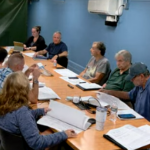By Kevin Stacey
Special to the Independent
“Now that I’m 51, my best days are behind me. My business is going to go under due to COVID-19. I will most likely die alone, surrounded by 13 cats. The heck with all my futile searches for toilet paper. Should I just install a bidet? Would it spray only cold water, or is there a way to make it warm?”
Now that we’re into our second month of social isolation with the accompanying boredom, you’re probably becoming more aware of a process that is happening just as consistently as your breathing: your constant stream of thoughts. As demonstrated above, I like to call it “the noise.” It’s vital to keep in mind that there are always two entirely distinct things: the situation you’re faced with, as in COVID-19, and your thoughts about the situation.
I’m not saying that you shouldn’t feel anxious during these challenging times. This is an unprecedented and stressful period in history. It’s important to acknowledge that. It’s OK to not be OK. We’re emotional beings and it’s healthy to feel and express your emotions to allow them to dissipate.
I’m talking about self-created and self-inflicted stress. It’s like death from a thousand paper cuts. It can be a constant undercut of anxiety and stress that depletes your peace of mind. If I’m having trouble sleeping at night, it’s my thoughts that are the culprit, not the situations in my life.
Now is a great time to work on mindfulness: becoming more aware and noticing the 50,000 or so thoughts we have a day without judgment or reaction. All kinds of various thoughts pop into our heads, some of which are illogical, and some that are downright outrageous. Just like dreaming. It’s part of the human experience.
It helps to realize that the brain has an evolutionary-based negativity bias. Because it’s still doing an outdated and obsolete job: keeping us safe from imminent physical danger so we can pass on our genes. We forget that since we’ve been walking upright for 4 million years, 5,000 years is a drop in the bucket. But the rate of change of human technological and societal progress has been off the charts throughout the last 500 years. Our poor brains have not been able to keep up. We evolve too slowly from genetic mutations. The brain is in desperate need of an update from the app store. The sad truth is our brains don’t care about the quality of our lives. That’s not relevant to its mission. The more anxious and vigilant you are, the better its chance to fulfill its mission of keeping us alive.
The default state of our brains is spontaneous wondering. Speculating on what’s wrong and what could go wrong. To come up with dirt. They present thoughts that masquerade as truth or logic. They create internal fake news that appears as breaking and headline-worthy front page news. Studies show that for most of us, 77 percent of our daily thoughts are negative or counterproductive. If we’re not careful, we can allow any one of them to become a major “story” in our lives.
I’ve been so relieved to grasp that a thought is just a thought. Nothing more. Here is how I define a thought: a brain secretion. Just because my brain created the thought doesn’t mean I have to own it, that it’s true, or worthy of rumination. A thought has no power unless you give it some. The problem isn’t that we have negative thoughts; the problem is that we pay attention to them. People who aren’t anxious or depressed have the same negative thoughts everyone else does. They just have a different relationship with them.
One disclaimer is if you have a diagnosis, like my brother with bipolar disorder. Some of us have a chemical imbalance and need extra help in the form of medication and professional services to deal with thoughts and mental activity.
But most of us can do a better job at catching ourselves sooner, before we allow our thoughts to become front-page news. We can interrupt a train of thought. We can stop a mild anxiety or depressive episode from turning into a clinical or debilitating one.
The best thing to do is think of the mind and the brain as two separate things. Realize that the brain is the creator of the thoughts, but you are the director and producer. Use your mind to train your brain. You decide which trains of thoughts will play on screen of your consciousness. The goal isn’t to think only positive thoughts, that’s exhausting. The goal is to only entertain positive trains of thought. Catching myself and simply defining it as a thought takes its power away. It’s liberating. So, “Should I try to make my own ventilator?” I simply declare to myself, “There’s a thought!”
Kevin Stacey is founder and CEO of TrainRight, Inc., helping organizations and executives reach their full potential, and author of “MindRight: Navigate the Noise.” More info is available at KevinStacey.com.






















0 Comments